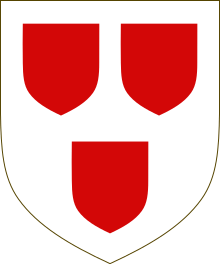William Hay, 4th Earl of Erroll
William Hay, 4th Earl of Erroll (1470 – 9 September 1513), styled as Lord Hay until 1507, was a Scottish peer and soldier. He was killed at the Battle of Flodden.
The Earl of Erroll | |
|---|---|
 Arms of the Earl of Erroll | |
| 8th Lord High Constable of Scotland | |
| In office 1507–1513 | |
| Preceded by | William Hay |
| Succeeded by | William Hay |
| Personal details | |
| Born | 1470 Huntly, Aberdeenshire, Scotland |
| Died | 9 September 1513 (age 42 or 43) Battle of Flodden, Northumberland, England |
| Spouse(s) | Christian Lyon Margaret Kinloch |
Biography
William Hay was the son of William Hay, 3rd Earl of Erroll. He had double royal lineage: his grandfather, William Hay, 1st Earl of Erroll was a great-great grandson of King Robert II of Scotland; and his maternal grandfather was James I of Scotland.[1]
He served as the Lord High Constable of Scotland, a hereditary title that was, after the king, the supreme officer of the Scottish army. He was killed on 9 September 1513 in the Battle of Flodden, near Branxton, Northumberland. He died alongside his younger brother Thomas, King James IV of Scotland and more than a dozen dukes and earls in a decisive English victory.[2]
Marriage and issue
He married Christian Lyon, daughter of John Lyon, 3rd Lord Glamis, and had two children:
- William Hay, 5th Earl of Erroll (c. 1495, Errol, Perthshire, Scotland – 28 July 1522 in Edinburgh)
- Lady Isabel Hay
He married secondly Margaret Kinloch of Cruvie, widow of Sir James Sandilands, 5th feudal baron of Calder.
Ancestry
| Ancestors of William Hay, 4th Earl of Erroll | ||||||||||||||||||||||||||||||||||||||||||||||||||||||||||||||||||||||||||||||||||||||||||||||||||||||||||||||||||||||||||||||||||||||||||||||||||||||||||||||||||||||||||||||||||||||||||||||||||||||||||||||||||||||||||||||||||||||||||||||||||||||||||||||||||||||||||||||||||||||||||||||||||||||||||||||||||||||||||||||||||||||||||||||||||||||||||||||||||||||||||||||||||||||||||||||||||||||||||||||||||||||||||||||||||||||||||||||||||||||||||||||||||||||||||||||||||||||||||||||||||||||||||||||||||||||||||||||||||||||||||||||||||||||||||||||||||||||||||||||||||||||||||||||||||||||||||||||||
|---|---|---|---|---|---|---|---|---|---|---|---|---|---|---|---|---|---|---|---|---|---|---|---|---|---|---|---|---|---|---|---|---|---|---|---|---|---|---|---|---|---|---|---|---|---|---|---|---|---|---|---|---|---|---|---|---|---|---|---|---|---|---|---|---|---|---|---|---|---|---|---|---|---|---|---|---|---|---|---|---|---|---|---|---|---|---|---|---|---|---|---|---|---|---|---|---|---|---|---|---|---|---|---|---|---|---|---|---|---|---|---|---|---|---|---|---|---|---|---|---|---|---|---|---|---|---|---|---|---|---|---|---|---|---|---|---|---|---|---|---|---|---|---|---|---|---|---|---|---|---|---|---|---|---|---|---|---|---|---|---|---|---|---|---|---|---|---|---|---|---|---|---|---|---|---|---|---|---|---|---|---|---|---|---|---|---|---|---|---|---|---|---|---|---|---|---|---|---|---|---|---|---|---|---|---|---|---|---|---|---|---|---|---|---|---|---|---|---|---|---|---|---|---|---|---|---|---|---|---|---|---|---|---|---|---|---|---|---|---|---|---|---|---|---|---|---|---|---|---|---|---|---|---|---|---|---|---|---|---|---|---|---|---|---|---|---|---|---|---|---|---|---|---|---|---|---|---|---|---|---|---|---|---|---|---|---|---|---|---|---|---|---|---|---|---|---|---|---|---|---|---|---|---|---|---|---|---|---|---|---|---|---|---|---|---|---|---|---|---|---|---|---|---|---|---|---|---|---|---|---|---|---|---|---|---|---|---|---|---|---|---|---|---|---|---|---|---|---|---|---|---|---|---|---|---|---|---|---|---|---|---|---|---|---|---|---|---|---|---|---|---|---|---|---|---|---|---|---|---|---|---|---|---|---|---|---|---|---|---|---|---|---|---|---|---|---|---|---|---|---|---|---|---|---|---|---|---|---|---|---|---|---|---|---|---|---|---|---|---|---|---|---|---|---|---|---|---|---|---|---|---|---|---|---|---|---|---|---|---|---|---|---|---|---|---|---|---|---|---|---|---|---|---|---|---|---|---|---|---|---|---|---|---|---|---|---|---|---|---|---|---|---|---|---|---|---|---|---|---|---|---|---|---|---|---|---|---|---|---|---|---|---|---|---|---|---|---|---|---|---|---|---|---|---|---|---|---|---|---|---|---|---|---|---|---|---|---|---|---|---|---|---|---|---|---|---|---|---|---|---|---|---|---|---|---|---|---|---|---|---|---|---|---|---|---|---|---|---|---|---|---|---|---|---|---|---|---|---|---|---|---|---|---|---|---|---|---|---|---|---|---|---|---|---|---|---|---|---|---|---|---|---|---|---|---|---|---|---|---|---|---|---|
| ||||||||||||||||||||||||||||||||||||||||||||||||||||||||||||||||||||||||||||||||||||||||||||||||||||||||||||||||||||||||||||||||||||||||||||||||||||||||||||||||||||||||||||||||||||||||||||||||||||||||||||||||||||||||||||||||||||||||||||||||||||||||||||||||||||||||||||||||||||||||||||||||||||||||||||||||||||||||||||||||||||||||||||||||||||||||||||||||||||||||||||||||||||||||||||||||||||||||||||||||||||||||||||||||||||||||||||||||||||||||||||||||||||||||||||||||||||||||||||||||||||||||||||||||||||||||||||||||||||||||||||||||||||||||||||||||||||||||||||||||||||||||||||||||||||||||||||||||
References
- Mackintosh, John (1898). Historic Earls and Earldoms of Scotland. W. Jolly.
- James Balfour Paul (1906). The Scots Peerage: Volume 3. D. Douglas. pp. 565–566.
| Military offices | ||
|---|---|---|
| Preceded by William Hay |
Lord High Constable of Scotland 1507–1513 |
Succeeded by William Hay |
| Peerage of Scotland | ||
| Preceded by William Hay |
Earl of Erroll 1507–1513 |
Succeeded by William Hay |